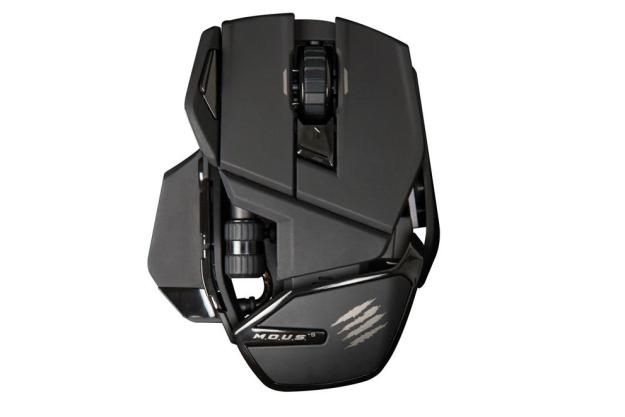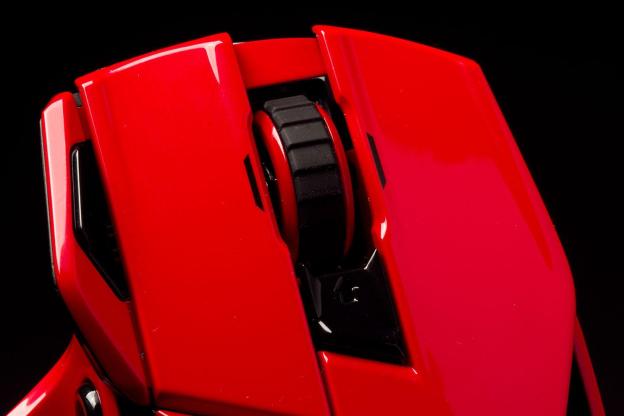
“Though packed with features, the overpriced M.O.U.S.9 tosses the adjustability that made its predecessor, the R.A.T, unique. Its cheap plastics and lack of ergonomic design are unworthy of a mouse sold for half as much.”
- Includes zoom wheel and precision control button
- Adjustable palmrest
- Plastics look cheap
- Poor ergonomics
- No hardware DPI adjustment
- Extremely overpriced
Three years ago, gaming peripheral do-it-all Mad Catz surprised everyone by coming out with an extremely unusual mouse, the R.A.T, which stood out because of its incredible adjustability. Want to change the grip? No problem. Want to make the mouse shorter? You could do that too. No other mouse at the time could do the same, making it an instant hit with gamers.
The problem is the plastics: they look cheap and chintzy, words not at all fitting for a peripheral that comes in well above $100.
Aiming this mouse at a different market puts it up against less competition, but that’s a double-edged sword. Even power-users have a hard time parting ways with more than $50 for a mouse, yet Mad Catz has priced this model at a stratospheric $130. Let’s see if the M.O.U.S.9 can justify its elephantine price tag.
A candy coated shell
The M.O.U.S.9 comes in black, white, or red – a selection that fits a range of tastes (black for subtly, white for class, and red for punch). In photos, they all look sophisticated and serious: knobs, dials, and buttons are everywhere, providing the mouse with an authoritative, almost intimidating aura.
Yet, this mystique doesn’t hold up to closer inspection. The problem is the plastics: they look cheap and chintzy, words not at all fitting for a peripheral that comes in well above $100. Perhaps the greatest sin is the flimsy battery cap, which is held on by nothing more than a plastic lip and must be crudely rotated to remove or install the single AA battery. Yeah, sure, it’s just a cap, but consumers who pay this much for a mouse will rightly expect an unusual level of quality. And Mad Catz doesn’t deliver.

The cheap exterior is doubly unfortunate because a robust metal frame lies underneath the cheap plastics, giving the mouse reasonable heft and a sense of durability that’s not available in less expensive products. We’re puzzled why this impressive foundation is hidden by so much glossy, gaudy plastic.
What’s that button for?
Mad Catz crammed almost every feature imaginable into the M.O.U.S.9, including the typical functions of a five-button mouse, which includes a zoom/horizontal scroll wheel, a precision control button, and a magnifier. All of these are configurable using drag-and-drop software available from the company’s website.
…consumers who pay this much for a mouse will rightly expect an unusual level of quality. And Mad Catz doesn’t deliver.
For all the M.O.U.S.9 offers, one feature is noticeably absent: adjustability. Only the palmrest can be customized, and only by moving it forward or back. All of the other adjustments found on the R.A.T. are gone, which seems to defeat the point. We’re also annoyed by the lack of a hardware on-the-fly DPI adjustment button, which is a feature many gaming mice offer, and a feature we’d be happy to see on a premium everyday mouse.
Ergonomic nuisances
The lack of adjustability is particularly puzzling because the M.O.U.S.9 obviously copies the design of the R.A.T, which is an unattractive device that puts function over form. With the function stripped out, we’d expect the form to be improved, but, instead, it’s largely unchanged.
Ergonomic woes are the obvious result. Users with small hands may find the mouse too large, even with the palmrest adjustment fully retracted, yet those with very large hands may find the design a bit too narrow. And everyone will dislike the blocky design, which offers plenty of hard edges that can dig into skin over time.
Button placement could be better, too. The rear left-side button (which defaults to “back” in a Web browser) is a bit too far back to be convenient, and the precision control button is a bit too far forward for most people to access from a natural position. Even the zoom wheel, which is placed just behind the forward/back buttons, requires a stretch to access.
Conclusion
The M.O.U.S.9 could have brought the R.A.T’s signature adjustability to the masses. Instead, it strips out most of that unique functionality and replaces it with a heaping dose of nothing. Sure, the mouse offers Bluetooth 4.0 and a laser that works on glass, but neither feature is unique or particularly interesting.
Most damning, however, is the general lack of quality and attention to detail. Though priced at a whopping $130, the device suffers from cheap plastics and a lack of ergonomic design that’d be unworthy of a mouse sold for half as much.
We’re puzzled why the M.O.U.S.9 exists. Mad Catz’s wireless R.A.T.9 sells for the same price, doesn’t sacrifice adjustability, and offers most of the same features. While labeled a “gaming mouse,” the top-end R.A.T. seems superior in every way, and for every user.
Highs
- Includes zoom wheel and precision control button
- Adjustable palmrest
Lows
- Plastics look cheap
- Poor ergonomics
- No hardware DPI adjustment
- Extremely overpriced




